If there’s a recession in 2019, here’s what marketers should do
The dreaded R-word in marketing is making a comeback. No, not retargeting. Recession.

/ Photo by Matthew Henry on Unsplash
In the US, the partial shutdown of the federal government imperils an economy that may already be slowing. In the UK, businesses are heading into the unknown abyss of Brexit with no ad budget growth last quarter. For the first time since the Great Recession, marketers may see significant budget cuts in 2019.
After the 2008 stock market crash, newspaper advertising spend in the US fell by 27%; radio, 22%; magazine, 18%; outdoor, 11%; TV, 5% and online, 2%. The entire ad market declined by 13%. Moreover, ad agency revenue growth is historically a lagging indicator for GDP – meaning that any change in economic growth hits agencies a few quarters later.
So far, it is not looking good. Last week’s Bellwether Report (PDF on my website here) from the UK’s Institute of Practitioners in Advertising (IPA) found that business confidence is falling. (Predictably, short-term marcom spend is also increasing in response while long-term allocations are decreasing – more on that later.)
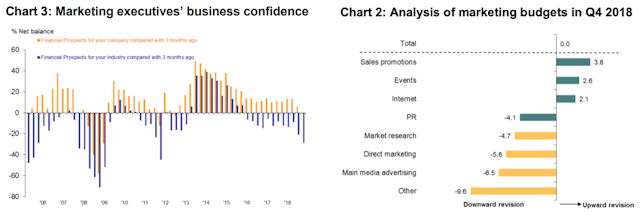
If marketers see leaner times this year, it will be critical to focus on profitable effectiveness – rather than empty “growth” – more than ever. After all, the economic principle of opportunity cost mandates that one dollar spent on one thing cannot be spent on another.
For this column, I reviewed a 2008 report from the IPA on marketing during downturns (PDF here) and its 2015 Creativity & Effectiveness Report (PDF here). An IPA spokesperson told me that the organisation may produce an updated version of the 2008 study. I also obtained a past Millward Brown (now Kantar Millward Brown) white paper on survival tactics during recessions (PDF here).
I also remembered my own experiences and interviewed marketers who have seen downturns to see how companies can help both short-term survival and long-term growth. Here is what I found.
Resist thinking only in the short-term
Thanks to the work of Les Binet and Peter Field collected at EffWorks, we know that advertising effectiveness has been declining as short-termism has been increasing.
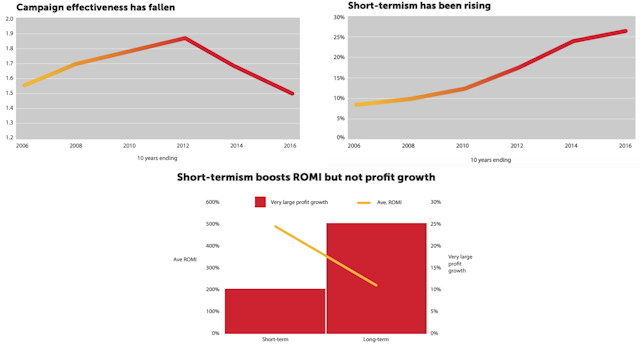
When the next recession hits, short-termism will become more of a problem. When a bear – economic or not – attacks, you think only about surviving until tomorrow. You do not think about dinner plans next month. The same is true in business.
Companies have direct control over money going out but not coming in, so the immediate response is to slash costs and focus on what will generate revenue tomorrow rather than in six months. But expense cutting should be decided strategically – and marketing departments can actually benefit in such a scenario.
“It is better to maintain SOV (share of voice) at or above SOM (share of market) during a downturn: the longer-term improvement in profitability is likely to greatly outweigh the short-term reduction,” the IPA’s 2008 report states. “If other brands are cutting budgets, the longer-term benefit of maintaining SOV at or above SOM will be even greater.”
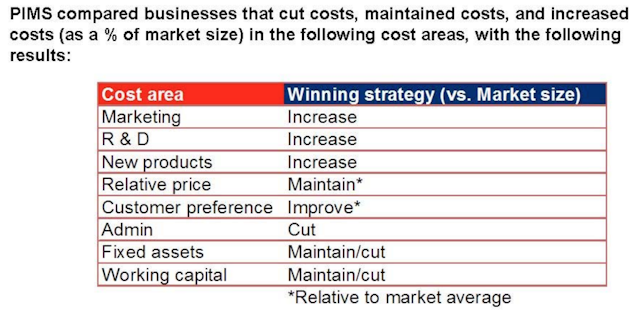
“Whilst maintaining or reducing fixed costs was desirable, the opposite was true of marketing costs,” the IPA also stated. “Communications, R&D and new product development were all areas where increased expenditure was associated with business success during downturns. Improving customer preference whilst enabling maintained relative price were the means by which increased marketing expenditure drove success.”
Yes, people in other departments will complain that marketing gets more money while others receive cuts. But marketing encompasses everything that brings money into a business. Everything else is essentially finance or operations.
“A reduction in brand focus doesn’t work long-term,” Sarah De Martin, UK managing director at digital agency Artefact, said. “Performance marketing doesn’t make returns without consistent brand-building, so continual investment remains key [in recessions].”
Do not cut advertising spend
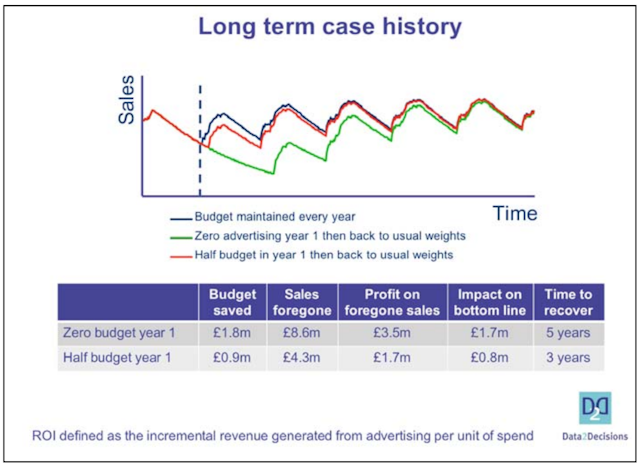
Some of the IPA’s other findings in 2008:
“Following a budget cut, a brand will continue to benefit from the marketing investment made over the previous few years. This will mitigate any short-term business effects, and will result in a dangerously misleading increase in short-term profitability. The longer-term business harm will be more considerable, but will not be noticed at first."
“Two key constituent brand relationship metrics – brand usage and brand image – suffered considerably when brands ‘went dark’ (ie, ceased to spend on communications) for a period of six months or more."
“A brand judged to be on the way down, because it has fallen silent, will very rapidly see this manifested in word-of-mouth, which will accelerate the perception of failure.”
“Brands in categories that are more price-driven and where brands carry less importance to consumer choice (such as motor fuel, mineral water and apparel) are more susceptible to share loss when cutting budgets. Conversely, brands in categories where the reverse is true (such as luxury cars, financial services and fragrances) tend to be more resilient.”
Amanda Lewis, group business development director at AKA, an entertainment and leisure agency, said that “in a time of uncertainty, it’s a common mistake for marketers to cut marcom spend”.
“Marketers should focus their budget on raising the brand’s profile and awareness. While increasing marcom spend might be swimming against the tide, it can allow marketers to reap the rewards of capturing consumers’ attention by keeping them engaged long-term.”

According to the IPA’s 2015 report, excess share of voice fell sharply after the 2008 crash. (ESOV is share of voice minus share of market. Ideally, a company’s share of voice should be higher than its market share.)
Some of the additional findings:
“Many have been encouraged by a growing, but unfounded, belief that ESOV is no longer important in the digital age; that market forces linking investment to impact no longer apply. [But] lower ESOV results in lower levels of market share growth. Small brands may need around five points of ESOV simply to maintain market share.”
“If ESOV is cut to negative levels, awarded campaigns are likely to achieve less growth than non-awarded ones, meaning that the benefit of investment in creativity will have been wasted.”
Focus on core brands and creativity
Recessions should be the time that unsuccessful brands die or are sold off because stronger brands support price premiums even in tough economic times, according to the Millward Brown report. (Remember Nautica clothes in the 1990s? The brand was sold to VF Corporation after the early-2000s recession.)
“Concentrate on your core brands and products. Now is not the time to spread scarce resources across multiple brands or product variants,” the report states. “Recessions may call for a triage strategy. Concentrate your marketing muscle behind the brands that are most likely to survive, and leave the others to sink or swim.”
“During the Argentinean economic crisis of 2002, Unilever made it possible for people to buy the Skip laundry brand by making small packages available, which carried a low unit price. They also introduced large economy sizes that offered people a better deal.”
Millward Brown also recommends that marketers double down on creativity, noting that: “creative had five times as much impact on profit as did budget allocation. Now more than ever, you need to set the bar high and leverage your media budget as effectively as possible. Test a range of solutions for each channel. Pre-testing is cheap in comparison to wasting millions on ads that fail to evoke the desired response.”
I concur. As I noted in a prior column on how optimisation is the enemy of creativity, creative campaigns deliver a profit multiplier of at least tenfold.
Now, it is one thing for marketers to know that their budgets should not get cut during recessions. But it is another to convince the boardroom, especially finance or chief executives who may know little about marketing.
If you are forced to make cuts in any future recession, here are two specific recommendations to limit the damage and maximise effectiveness. (But remember that every company will have different circumstances.)
Cut most of your 'content'
Unless you are an actual media company – rather than a consumer brand or software producer that pretends to be one – you can safely stop most 'content' production.
I once had various high-tech software companies as clients at an agency. Part of my job was to write countless blog posts that the clients would then spam around the internet to get website clicks (and hopefully sales leads). Yes, it was direct response by a new name.
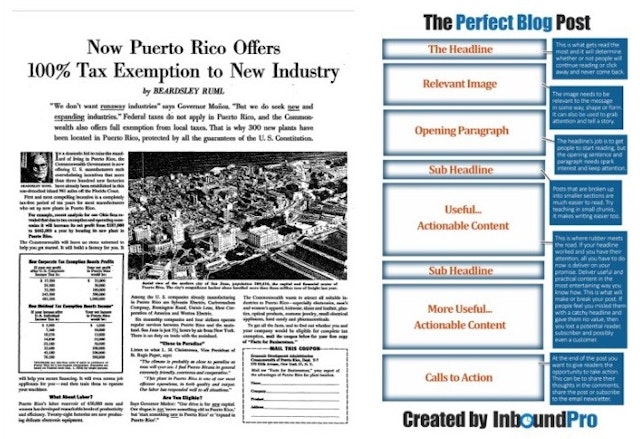
I cannot disclose the specific results, but I can say that the results of such 'content marketing' in general follow the pattern of a typical long-tail curve – at best.

The X axis is the number of customer leads. The Y axis is each blog post listed in order from most to fewest leads. Only a few – the 20% in green – resulted in any significant benefit. Those in yellow were a bigger waste of time and money than S Club 8.
What did the green ones have in common? They were each produced as part of a specific, tactical marcom effort in terms of advertising, PR campaigns or search engine optimisation. The ones in yellow – which were published just to publish something to spread around the internet for clicks – were useless.
The best practice in marcom has always been to create prioritised tactical and media mixes by deciding what tactics to use (and not use) and where to use (and not use) them within an overall strategy. First, decide the tactics and channels – and then decide the collateral you will produce for each campaign. A website is just another channel that can be used.
But most 'content marketing' fails because it skips those two parts of the process. It mass produces and distributes anything and everything without any strategic or tactical thought. All that matters is that you make and transmit 'widgets' with direct-response calls to action next to them.
Is it little wonder, then, that we see these results?
- Marsha Lindsay of BrandWorks University said at EffWeek that there is a “content crisis” because output per brand per channel is up 35% per year but engagement is down 17%
- A Meaningful Brands survey released by Havas found that 60% of the world’s brands create “content” that is absolutely useless
- Mark Higginson posted at Econsultancy that “barring a few outliers, the majority of content published to these sites receives next to no links and goes nowhere, receiving few shares"
- Beckon chief executive Jennifer Zeszut told VentureBeat that “the current wisdom that brands need to be content machines is simply not supported by the data”
Rand Fishkin, the Moz cofounder who now runs SparkToro, also recently questioned the current effectiveness of company blogs.
“10 years ago, blogs were a content format that had been on the rise for the better part of a decade and continued to rise fast,” he wrote. “Almost every content network – Facebook, Twitter, LinkedIn etc – supported them and helped them grow reach. Now, that’s no longer the case.”
To maximise effectiveness in a recession, the resources spent on most 'content' are best allocated elsewhere.
Delete your social media
The basic idea of 'social media marketing' has always been to post whatever gets 'engagement' with the goal of getting shares, followers, impressions and website clicks. But every argument for doing that has been proven completely wrong.
Want to grow a following so potential customers will see your page’s 'content'? Facebook today gives reach mainly to what receives 'paid' support. And that is just advertising over a different channel. Want a large follower count to look credible? You can buy that.
Want 'engagement'? Does anyone remember the Facebook posts that they 'liked' or commented upon the prior day? The real long-term value is questionable at best. Unless you are selling something to marketers – who love social media – or work in a few specific industries, social media is largely useless.

That image is from a video of a Chinese click farm promoting something on social media. As Epoch Design head of planning Alex Murrell, CBC columnist Ramona Pringle and Washington Post director of adtech Aram Zucker-Scharff all recently noted, everything online is fake.
Just see this study by Engagement Labs: “there is little to no relationship between the conversations happening on social media versus those that happen in real life.” In my prior column, I highlighted a recent Ebiquity study showing that only 0.67% of Facebook advertising impressions are quality enough to build brands.
And for the love of David Ogilvy, I will never understand why companies conduct customer support publicly on social media. Just see the flack that Slack got last week when the company released a new, divisive logo. Social media rarely builds brands but certainly inspires people to damage them. There is little to gain and much to lose from being there.
If most companies would close their social media accounts tomorrow, nothing would change. To maximise effectiveness in a recession, the resources spent there are also best allocated elsewhere.
If the economy declines in 2019, I will not envy the executives who will make many tough choices. I worked in the agency world during the aftermath of the 2008-9 economic meltdown, and it was terrible. But at least it was not as bad as S Club 8.
The Promotion Fix is an exclusive biweekly column for The Drum contributed by global keynote marketing speaker Samuel Scott, a former journalist, newspaper editor and director of marketing in the high-tech industry. Follow him on Twitter. Scott is based out of Tel Aviv, Israel.

